Bruce and Trina
Polytown

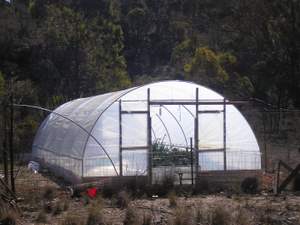
Our polytunnel story is a long and ongoing one. Dubbed “Polytown” by our daughter, it spent about ten years in the imagination and took more than three years to build. Polytunnels built from kits can be erected in a couple of days, but we built ours from scratch (including making the hoops) and two babies arrived to distract us along the way. However, it’s been well worth the effort as it continues to provide us with an abundance of vegetables despite unpredictable and harsh frosts. Our polytunnel is consistently at least 5 degrees warmer than the outside temperature.
For us, building a polytunnel is part of a dream of greater self-sufficiency. We want to grow more of our own food, and a polytunnel extends extends the growing season and better protects our crops. In our area frosts come early and late. If you try to grow anything even vaguely frost sensitive you can lose it at any time.
Our second major motivation is a desire for top quality produce. It's remarkable how much better home-grown or organic vegetables and fruit taste and make you feel. We want to know what our food has been grown in and be certain that it is fresh and chemical free.
There is a great sense of satisfaction in growing your own food. The majority of our family's diet is vegetables, and now we have a ready supply. Of course we save money too, I'd estimate $50-$80 a week.
Polytunnel size and configuration
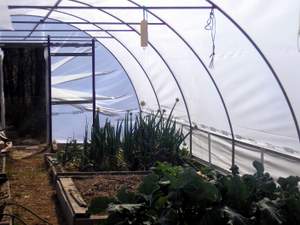
At 4m x 12m, our polytunnel is large for a home setup. It's oriented NE-SW (the ideal is to place the long axis north-south). Inside there are eight raised vegetable beds, each approximately 1.5m x 2-2.5m. There are four beds along each wall, separated by narrow paths to allow tending the plants without stepping on the beds. The polytunnel is within a larger fenced off area of about 15m x 20m. Our intention is to build up an orchard around the tunnel and eventually enclose that to protect the fruit from birds.
Placement of polytunnel
In an ideal world, you orient your polytunnel north-south on flat, fertile ground in a sunny position close to your house. In reality, gardeners have to make the best of the elements available.
Our Polytown is positioned beside the creek where the most fertile soil on the block is. This is also downhill from the dam and tanks allowing gravity driven irrigation. It's built over the site of an old worm farm so the soil is rich with castings and actually there are a number of surviving worms. It's a reasonably flat and clear area with good aspect for sunlight, which can be tricky to find when you live in a rocky and bushy area with many large eucalypts.
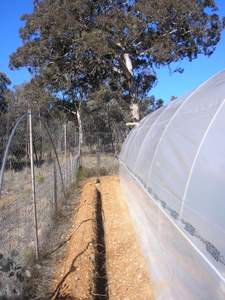
The drawback for us is that although this is the closest viable position for our polytunnel, it's 400m from the house. This doesn't sound like much but isn't very convenient for frequent harvesting - it's still quicker than driving 20 minutes to the supermarket though. We often use an old mountain bike to ride back and forth to pick veggies.
Polytown is surrounded by a 1.8m high, half metre extended fence to keep out roos, wombats and rabbits. The vegetable beds are bordered with besa blocks as termites eat through wooden edges, even sleepers. There's also a 50cm deep trench to be filled with sheeting as a barrier against eucalyptus roots.
Polytunnel ventilation
The polytunnel has doors at both ends to allow air to flow through. The polythene can be rolled up along the sides and propped up on V topped batons that wedge between the top and bottom rail.
Polytunnel building and materials
Polytown was built from scratch, not using a kit of any kind. The polytunnel was not really a planned project, but rather emerged out of opportunity. Bruce knew a bloke who'd built a device to bend steel tubes into hoops for the frame, and saved money by buying straight steel and bending enough hoops for two tunnels. These then lay around the block for about 7 years. Bruce didn't get inspired to continue building the polytunnel until we started having kids and wanted to feed them the healthiest food possible.
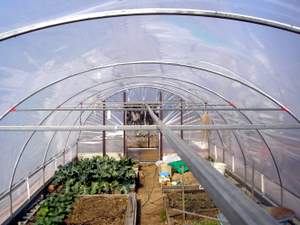
Crossbars had to be welded about 50cm from the top of every hoop to provide a position to attach a longitudinal brace. The brace couldn't be attached to the top of the hoops as the polythene cover would then catch and tear. The brace was necessary to strengthen the frame and prevent rocking and movement. It was a time-consuming task as it took ages to measure out where the crossbars should be welded allowing for the angle of the hoops. The welding took about half a day, but the friend that helped us with that is an expert blacksmith and no doubt did the job much faster than a mere mortal. We still owe him a case of Crownies.
Bruce then built the endpieces with bottom rails.
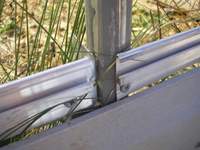
The next task was to set posts into the ground at 2m intervals for the hoops to be slotted into. Easy right? Wrong. For a start, our Polytown is on a slight slope. Secondly, we used string to measure the lengths, and the string must have stretched because our intervals worked out to be more like 2.1m. This was a time-consuming mistake to correct as Bruce then needed to put brackets on the posts in order to attach the siderails of the polytunnel. The side rails for attaching the polythene are drilled in with self-tapping screws.
The steel posts we've used are slightly bigger than the hoops, which slot into the posts. It would have been better to do it the other way around and use slimmer posts to slide into the hoop tubes so rainwater doesn't collect in the posts.
Then the most exciting part, putting on the cover. We missed putting the cover on for a season as we had an Autumn baby, and by the time we were ready to put on the plastic it was nearly Summer again.
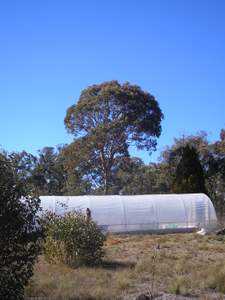
To get the cover on, Bruce set up two posts at one end of the polytunnel with the roll of polythene placed horizontally between them at the height of the polytunnel - kind of like a goal post. He also set up temporary rope supports along length of tunnel to stop plastic falling through. The top of the hoops are covered with a protective tape that minimises wear on the polythene. Bruce and Mike then pulled the polythene along either side of the polytunnel. This was probably the easiest part of the process, apart from stretching the polythene taut and smooth to attach to the siderails.
The polytunnel polythene film we've used is called Duratough, from Redpath. It has an anti-condensate internal side and transmits 88% of light. It has a 4-7 year life expectancy and a 4 year warranty. One of the major advantages of the way Bruce has built the polytunnel is that the cover should be easy to replace. With many kits you actually bury the plastic in the ground rather than attach it to siderails.
Budget
Approximate costs were:
- steel for hoops $400
- welding of crossbars - a case of Crownies
- endpieces $100
- posts $120
- brackets $50
- polythene (including siderails and tape) $600
- miscellaneous $30
This totals to $1200. We probably saved about $1500 building the polytunnel without a kit. In hindsight, this saving wasn't worth the extra time, labour and frustration. Bruce would have rathered hang out with the kids.
Delays
To be fair to ourselves, although the polytunnel took more than 3 years to build, the vegetable beds were productive while the frame was being erected around them.
Polytown kind of evolved from having the hoops and the dream, there was no firm plan about how to do it. A full-time job and two babies added to Bruce's distractions.
Polytunnel co-stars
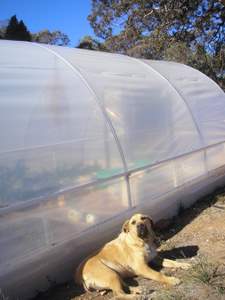
In the end we relied on family and friends for a great deal of help. Polytunnel co-stars include:
- Nonny - babysitting
- Sven - the hard labour (making raised vegetable beds and digging post holes)
- Simey - heavy lifting, water tank relocation and frame building
- Mike - welding and covering
- Roland and Clare - veggie planting
- Sue, Colin and Elspeth - olive tree planting
- Bob - fencing
- Jeremy - trench-digging
- Tessa - watering
- Indy the dog - observation and moral support
Reflections on Polytown
Next time we'll buy a kit! Apparently these can be put up in two days. Preparing and enclosing the polytunnel area was also a significant task for us, but erecting the polytunnel frame and covering it with polythene actually took weeks rather than days. The elapsed time was years!
I know that even when vegetable gardeners purchase a polytunnel kit, they still have to fiddle around clearing the ground, levelling as much as possible and measuring out exact lengths. However, at least the polytunnel itself is simpler to put together, with all the components provided.
At the moment we aren't collecting rainfall from the polytunnel roof, which we'd like to do.
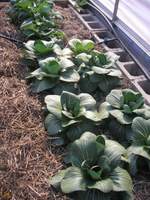
We're experimenting to find niche crops we can grow in bulk and then swap with neighbours who have mature fruit trees. So far bok choy, beets and broccoli are looking like particularly good polytunnel crops for winter.
We're enjoying experimenting with what will grow well, being surprised and impressed by the results. Bruce enjoys the lush, protected environment of the polytunnel while he's gardening. The smell of health soil and plants in the warmed atmosphere is divine.
Bruce's polytunnel tips
- Buy a kit.
- Stagger plantings to avoid gluts.
- Use companion planting to deter pests.
- Get your posts in the right position.
- Use a roller to hold the polythene when you're covering the frame.
- Be sure to cover frame with protective tape to minimise damage and help it slide into place.
- Have at least one other person on hand when you're putting on the cover.
- Place your polytunnel as close as possible to the house.
- Deal with pest outbreaks early to prevent spreading.
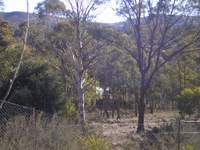
Click here for further information about
growing a vegetable garden in a polytunnel.

Check out The Polytunnel Handbook at Green Books. Just watching the promo video with Andy McKee and Mark Gatter is good for some tips and inspiration. Their polytunnel looks really well laid out - wish I'd seen this before we built ours!

Back to Vegetable Gardener Interviews from Bruce and Trina, Polytown
Back to Healthy Eating Guide home from Bruce and Trina, Polytown